Kyoto is home to numerous World Heritage Sites, collectively known as the “Historic Monuments of Ancient Kyoto.” These sites include temples, shrines, and castles, and are spread across Kyoto, Uji, and Otsu. Here is a list of all the World Heritage Sites in Kyoto:
The list of World Heritage Sites in Kyoto
Kyoto has 15 World Heritage Sites, making it one of the cities in Japan with the most World Heritage Sites.
Kiyomizu-dera Temple (清水寺)
Kiyomizu-dera Temple, located in eastern Kyoto, is one of Japan’s most iconic and historically significant Buddhist temples. Its name, which translates to “Pure Water Temple,” is derived from the Otowa Waterfall, where visitors can drink from three separate streams, each believed to confer a different blessing—longevity, success in school, or a fortunate love life.
The temple complex dates back to the late 8th century, although the current structures mostly date from the 17th century. One of its most striking features is the main hall, or Hondo, which is built atop a steep slope supported by hundreds of wooden pillars. This architectural marvel offers breathtaking views of the city, especially during the cherry blossom and autumn foliage seasons.
Kiyomizu-dera is also renowned for its association with the Buddhist deity of mercy, Kannon, and its role as a place of pilgrimage and prayer for centuries. The temple’s vibrant colors, intricate woodwork, and serene atmosphere make it a must-visit destination for both tourists and locals alike, offering a glimpse into Japan’s rich cultural and religious heritage.
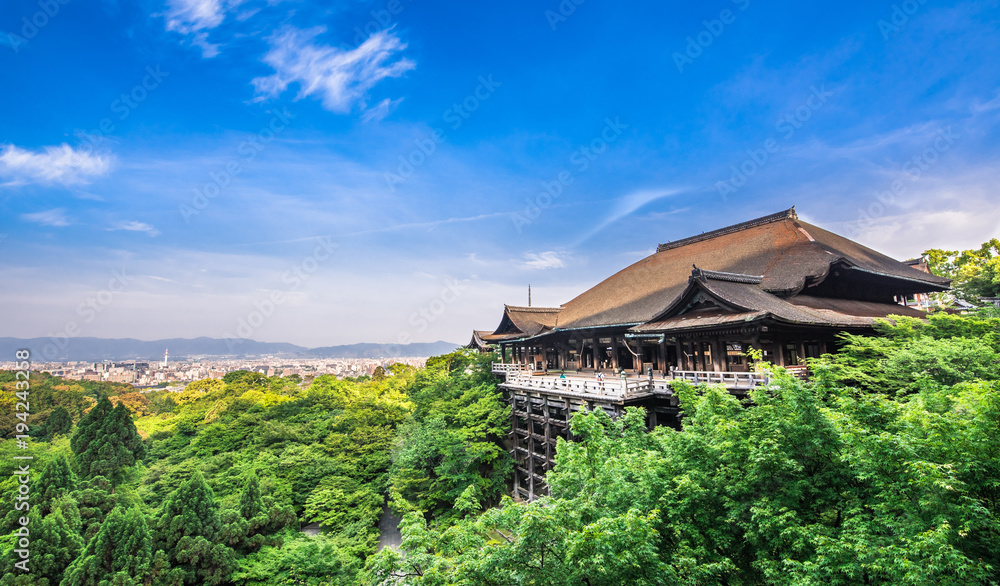
Kinkaku-ji (Golden Pavilion) (金閣寺)
Kinkaku-ji, also known as the “Temple of the Golden Pavilion,” is a historic monument situated in the northwest part of Kyoto city, Japan, representing one of the country’s most iconic architectural treasures. As its name suggests, the temple is renowned for its gleaming golden exterior.
Originally constructed in 1397 by Ashikaga Yoshimitsu as his retirement villa, Kinkaku-ji was later converted into a Zen Buddhist temple following his death. One of its most striking features is the three-story pavilion covered in gold leaf, creating a breathtaking reflection over the adjacent pond, resulting in a truly picturesque setting.
The temple’s meticulously manicured gardens further enhance its beauty, exemplifying the traditional Japanese aesthetics of tranquility and harmony. Kinkaku-ji holds significant cultural and historical importance in Japan, attracting numerous visitors from around the world who come to admire its beauty and learn about its rich history.
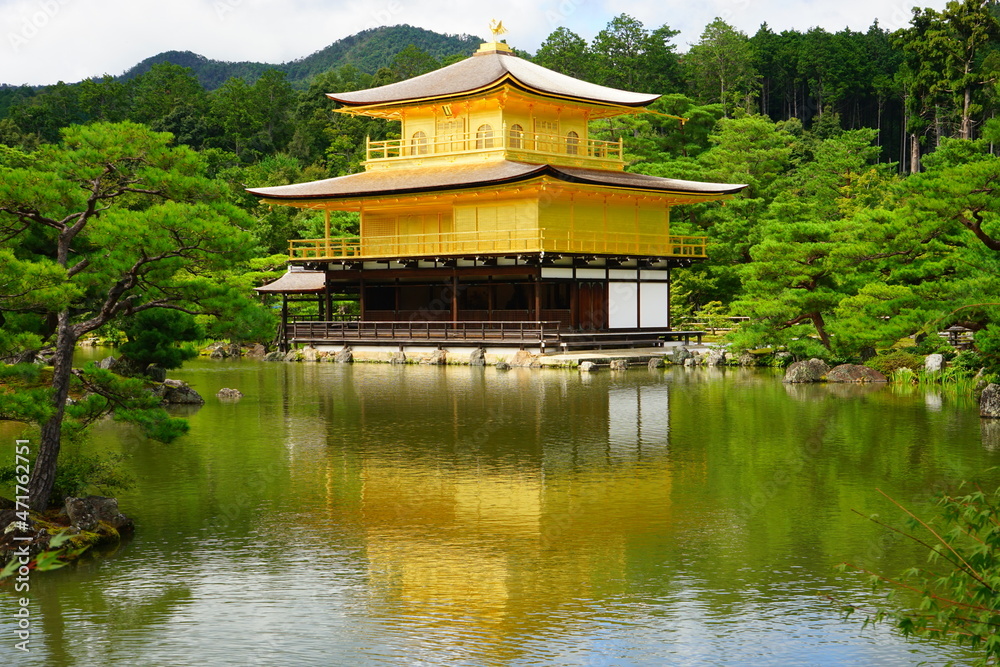
Ginkaku-ji (Silver Pavilion) (銀閣寺)
The Silver Pavilion, known as Ginkaku-ji in Japanese, is a renowned Zen Buddhist temple located in the northern part of Kyoto, Japan. Despite its name, the pavilion itself is not covered in silver; however, its elegant and understated design has earned it the nickname “Silver Pavilion.”
Constructed in the late 15th century by the shogun Ashikaga Yoshimasa, Ginkaku-ji was originally intended to be covered in silver leaf, similar to its counterpart, the Golden Pavilion (Kinkaku-ji). However, due to financial constraints and Yoshimasa’s death, the silver coating was never applied, leaving the temple with its natural wooden appearance.
The temple complex is surrounded by beautiful gardens, including the famous sand garden known as the “Sea of Silver Sand,” which is meticulously raked to resemble ocean waves. The gardens also feature moss-covered pathways, tranquil ponds, and carefully pruned trees, creating a serene and contemplative atmosphere.
Ginkaku-ji is considered a masterpiece of Japanese architecture and garden design, embodying the principles of wabi-sabi, which values simplicity, imperfection, and the transient beauty of nature. It holds cultural and historical significance as a symbol of the Muromachi period’s aesthetic ideals and continues to attract visitors seeking tranquility and inspiration.
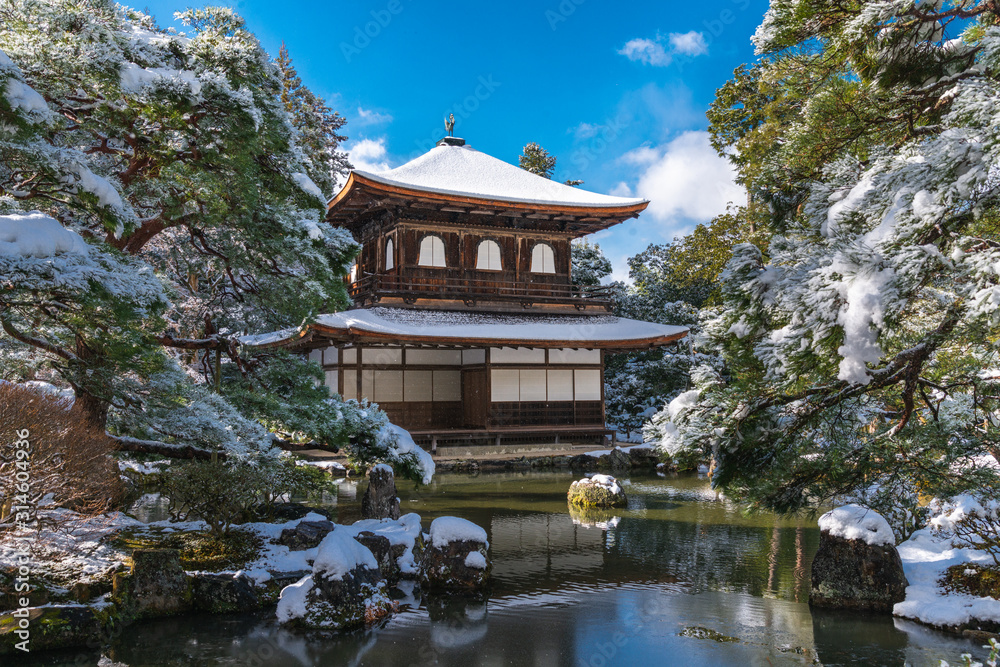
Ryoan-ji Temple (龍安寺)
Ryoan-ji Temple, located in Kyoto, Japan, is a Zen Buddhist temple renowned for its iconic rock garden, considered one of the finest examples of karesansui (dry landscape) gardens in the world. The temple was originally established in the late 15th century, although much of its current structures date back to the 18th century due to reconstructions following fires.
The centerpiece of Ryoan-ji is its rock garden, known as the “Tiger’s Den” garden, consisting of 15 carefully placed rocks set within a bed of meticulously raked white gravel. The arrangement of the rocks and the patterns in the gravel are designed to evoke a sense of calm and serenity, inviting visitors to contemplate the beauty of simplicity.
In addition to the rock garden, Ryoan-ji features other gardens, ponds, and walking paths that harmonize with the temple’s tranquil surroundings. The temple buildings themselves showcase elegant simplicity, reflecting the Zen aesthetic of austerity and minimalism.
Ryoan-ji Temple holds cultural and historical significance as a symbol of Zen Buddhism and Japanese aesthetic ideals. Its rock garden, in particular, has inspired artists, philosophers, and garden enthusiasts for centuries, making it a must-visit destination for those seeking moments of contemplation and reflection in the midst of Kyoto’s bustling cityscape.
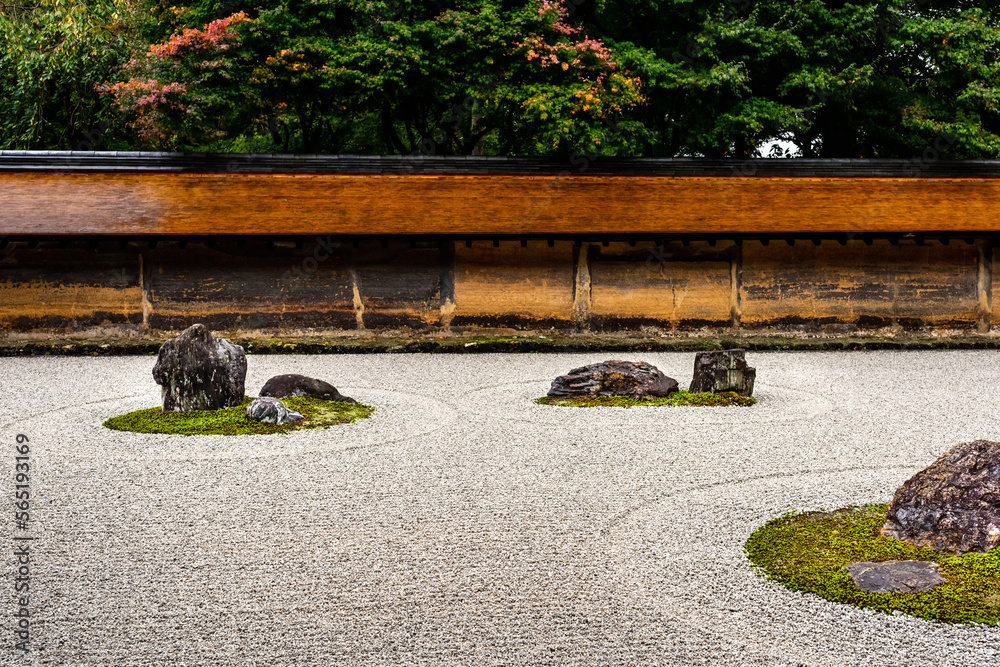
Ninna-ji Temple (仁和寺)
Ninna-ji Temple, located in Kyoto, Japan, is a significant historical and cultural site designated as a UNESCO World Heritage Site. Founded in the early 9th century by Emperor Kōkō, Ninna-ji is closely associated with the Tendai school of Buddhism and served as a center for Buddhist teaching and practice.
The temple complex boasts several notable structures, including the main hall (Kondo), the pagoda, and the beautiful Goten (Imperial Palace) with its elegant gardens. One of the most famous features of Ninna-ji is its stunning five-story pagoda, which stands as a symbol of the temple’s historical importance.
Ninna-ji is also renowned for its spectacular cherry blossoms, attracting numerous visitors during the spring season when the temple’s expansive grounds are adorned with delicate pink blooms. The temple’s tranquil atmosphere and lush greenery provide a serene retreat from the bustling city, making it a popular destination for both tourists and locals seeking moments of peace and contemplation.
Throughout its long history, Ninna-ji has played a significant role in the development of Japanese Buddhism and culture, and its architectural beauty and historical significance continue to be celebrated today.
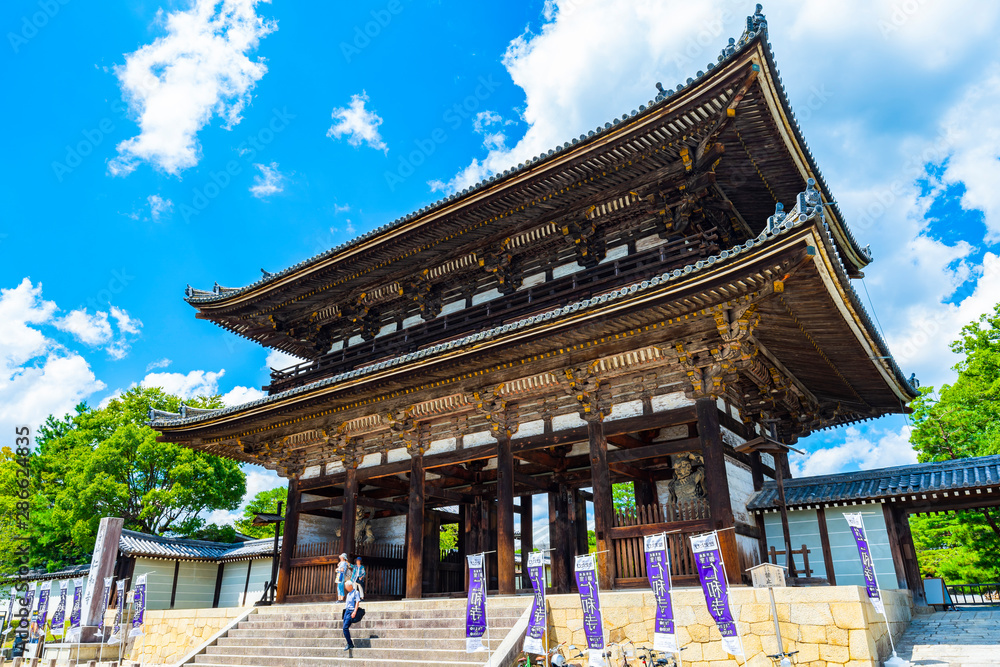
Tenryu-ji Temple (天龍寺)
Tenryu-ji Temple, situated in Kyoto, Japan, is a distinguished UNESCO World Heritage Site revered for its rich historical significance, stunning gardens, and association with the Rinzai sect of Zen Buddhism. Founded in 1339 by the ruling Ashikaga Takauji, Tenryu-ji was established to honor the late Emperor Go-Daigo and to serve as a center for Zen practice and learning.
The temple’s main hall (Hatto) is renowned for its elegant architectural design and serves as the venue for religious ceremonies and lectures. However, the highlight of Tenryu-ji is undoubtedly its magnificent garden, designated as a Special Place of Scenic Beauty. Designed by the renowned landscape architect Muso Soseki, the garden features a central pond surrounded by meticulously arranged rocks, trees, and lush vegetation. The garden’s composition is intended to evoke the natural landscape of mountains and rivers, providing visitors with a sense of tranquility and harmony.
Tenryu-ji is also famed for its association with the renowned Japanese ink painter, Sesshu Toyo, who created several masterpieces inspired by the temple’s serene surroundings. Additionally, the temple complex includes a bamboo grove, which adds to its scenic beauty and offers visitors a serene environment for contemplation and meditation.
As one of Kyoto’s most revered temples, Tenryu-ji continues to attract visitors from around the world who come to admire its cultural heritage, architectural beauty, and serene natural landscapes.
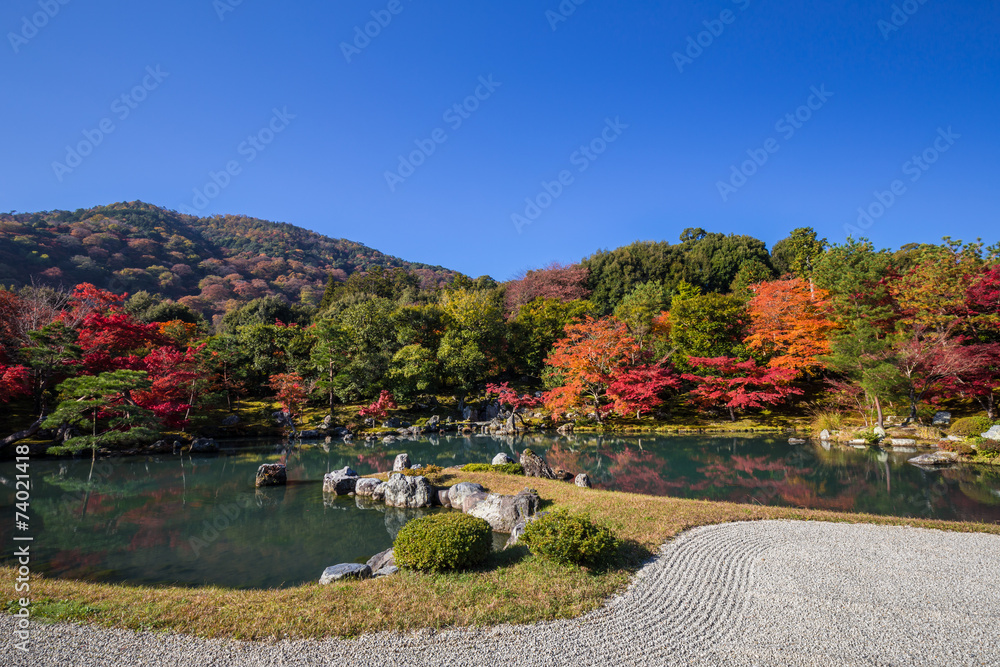
Saiho-ji (Kokedera, the Moss Temple) (西芳寺)
Saiho-ji, also known as Kokedera or the Moss Temple, is a UNESCO World Heritage Site located in Kyoto, Japan. Founded in the 8th century by the monk Gyoki, Saiho-ji is celebrated for its exquisite moss garden, which covers the temple grounds in a verdant carpet of various shades of green.
The garden at Saiho-ji is meticulously maintained and features over 120 varieties of moss, creating a serene and otherworldly atmosphere. Paths wind through the garden, leading visitors past tranquil ponds, stone lanterns, and small wooden bridges, providing opportunities for quiet reflection and contemplation.
To visit Saiho-ji, visitors must make a reservation in advance and participate in a traditional Zen ritual that involves copying Buddhist scriptures as a form of meditation. This practice, known as “shakyo,” is followed by a stroll through the garden, allowing participants to appreciate the beauty and tranquility of the moss-covered landscape.
Saiho-ji is regarded as one of Kyoto’s hidden gems, offering a peaceful retreat from the hustle and bustle of the city. Its unique moss garden and spiritual ambiance make it a must-visit destination for those seeking a deeper connection with nature and Japanese culture.
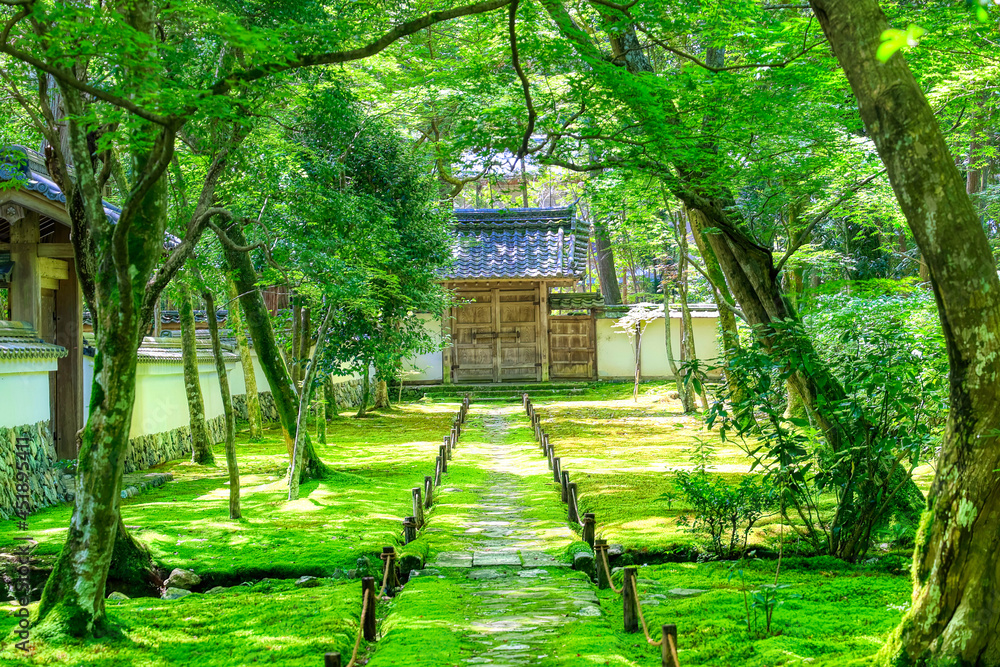
Kozan-ji Temple (高山寺)
Kozan-ji Temple is a Buddhist temple located in Sakyo-ku, Kyoto, and is registered as a UNESCO World Heritage Site. The temple was originally founded in the early Heian period and reconstructed during the Kamakura period. Kozan-ji is renowned for its beautiful gardens and rich cultural heritage.
One of the highlights of Kozan-ji is its garden. Praised as one of the most beautiful gardens in Kyoto, it is particularly famous as a spot for viewing autumn foliage. During the fall season, the entire garden is adorned with stunning shades of red and yellow, attracting numerous visitors.
Inside the main hall of Kozan-ji, there is an eleven-faced Kannon statue, revered as a sacred Buddhist site. Additionally, the temple houses numerous historical buildings and cultural artifacts, making it an intriguing destination for visitors interested in Japanese history and culture.
Kozan-ji is beloved by many for its beautiful gardens and rich historical background. When visiting Kyoto, one can enjoy the serene atmosphere and breathtaking scenery of Kozan-ji Temple.
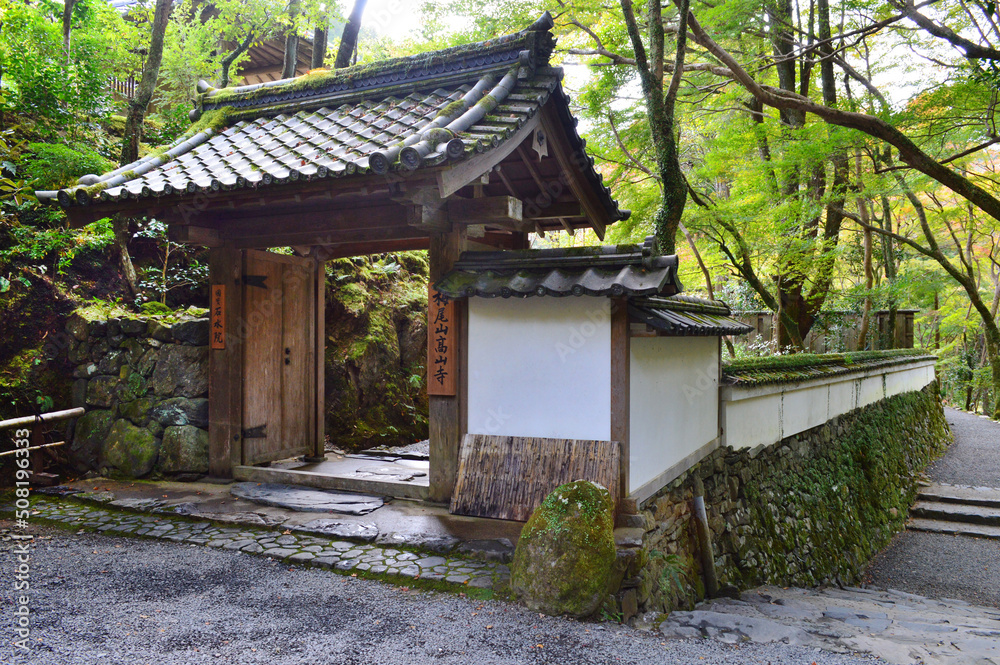
Nishi Hongan-ji Temple (西本願寺)
Nishi Hongan-ji Temple, located in Kyoto, Japan, is a UNESCO World Heritage Site renowned for its historical and cultural significance. Founded in 1602 by the influential monk Shinran, Nishi Hongan-ji serves as the head temple of the Jodo Shinshu sect of Buddhism.
The temple complex is comprised of several magnificent buildings, including the Amidado Hall (Hall of Infinite Light), the Goei-do Hall (Founder’s Hall), and the Shoin Hall (Study Hall). These structures showcase exquisite architectural designs and intricate woodwork, reflecting the rich cultural heritage of the Momoyama period.
One of the most notable features of Nishi Hongan-ji is its elaborate gardens, meticulously landscaped to create serene and contemplative spaces for visitors. The gardens feature lush greenery, tranquil ponds, and carefully placed stones, providing a peaceful retreat from the bustling city.
Nishi Hongan-ji Temple is not only a place of worship but also a center for cultural activities and community events. Throughout its long history, it has played a vital role in the development and spread of Buddhism in Japan and continues to be a cherished symbol of faith and tradition. As one of Kyoto’s most important religious sites, Nishi Hongan-ji attracts visitors from around the world who come to admire its architectural beauty and spiritual significance.
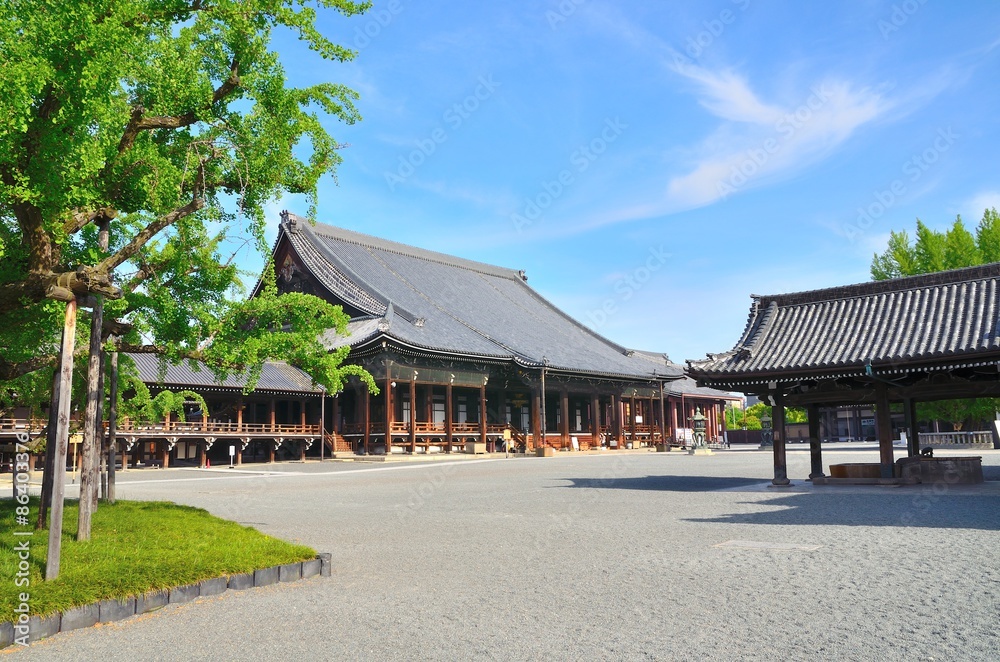
To-ji Temple (東寺)
To-ji Temple, a UNESCO World Heritage Site located in Kyoto, Japan, holds significant historical and cultural importance as one of the country’s oldest and most revered Buddhist temples. Founded in the early Heian period in 796 AD by Emperor Kammu, To-ji served as the head temple of the Shingon sect of Japanese Buddhism.
The temple complex is renowned for its impressive architecture, including the towering five-story pagoda, which stands as Japan’s tallest wooden tower at a height of 54.8 meters (180 feet). The pagoda, known as the “Great Pagoda of To-ji,” is a symbol of Kyoto and is particularly stunning during the cherry blossom season when it is surrounded by a sea of pink blooms.
In addition to the pagoda, To-ji features several other historic structures, including the Kondo (Main Hall), Kodo (Lecture Hall), and Miedo (Founder’s Hall). These buildings house various Buddhist relics, statues, and treasures, offering visitors insight into Japan’s religious and cultural heritage.
To-ji Temple is also renowned for its vibrant market held on the 21st of each month, known as the “To-ji Temple Market” or “Kobo-san Market.” This lively market offers a wide range of goods, including antiques, handicrafts, and local food, attracting visitors and locals alike.
As a center of Buddhist practice and cultural activity, To-ji Temple continues to play a vital role in Kyoto’s religious and social landscape, welcoming visitors from around the world to experience its rich history and spiritual ambiance.
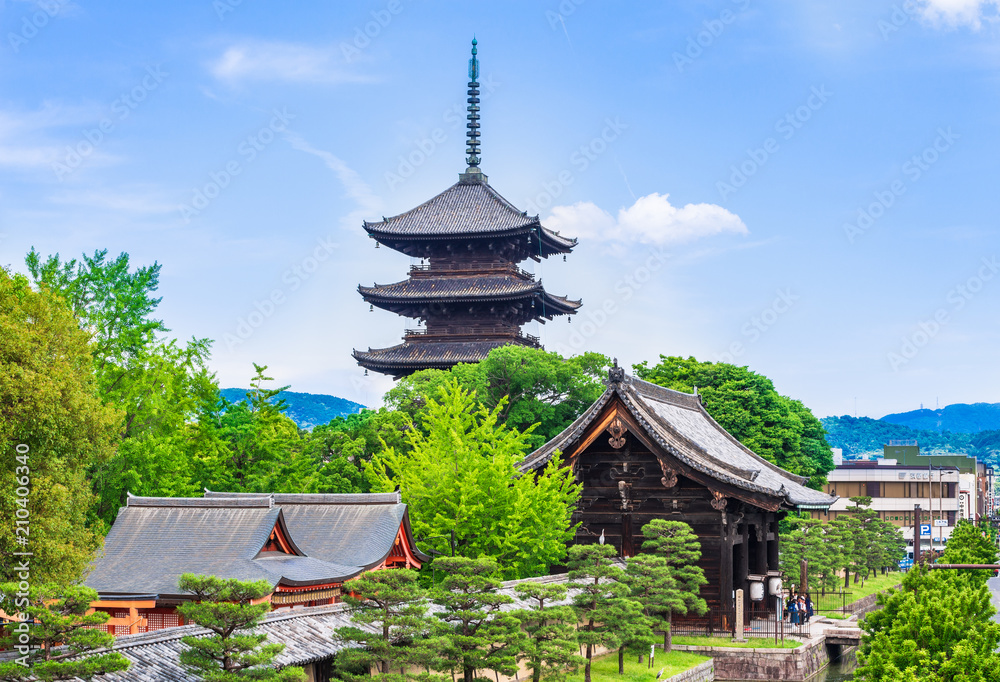
Daigo-ji Temple (醍醐寺)
Daigo-ji Temple, a UNESCO World Heritage Site located in Kyoto, Japan, is a significant cultural and historical landmark renowned for its stunning architecture, serene gardens, and profound spiritual significance. Founded in the early 9th century by the monk Shobo, also known as Rigen-daishi, Daigo-ji is affiliated with the Shingon sect of Japanese Buddhism.
The temple complex is nestled amidst the lush forests of the Higashiyama mountains, providing a tranquil and picturesque setting for visitors. One of the most iconic features of Daigo-ji is its five-story pagoda, which stands as a symbol of the temple’s enduring legacy and spiritual importance.
In addition to its architectural marvels, Daigo-ji is celebrated for its magnificent gardens, particularly the “Ryujin-no-ike” (Dragon King Pond) garden and the “Sanbo-in” garden. These meticulously landscaped gardens feature serene ponds, meandering streams, and vibrant flora, creating a peaceful oasis for meditation and contemplation.
Daigo-ji Temple is also renowned for its annual cherry blossom festival, known as the “Daigo Cherry Blossom Festival,” held in spring when the temple grounds are adorned with thousands of cherry blossoms in full bloom. This breathtaking spectacle attracts visitors from around the world who come to admire the beauty of nature and partake in traditional Japanese cultural festivities.
As a bastion of Japanese spirituality and cultural heritage, Daigo-ji Temple continues to inspire awe and reverence among visitors, offering a glimpse into Japan’s rich religious traditions and natural beauty.
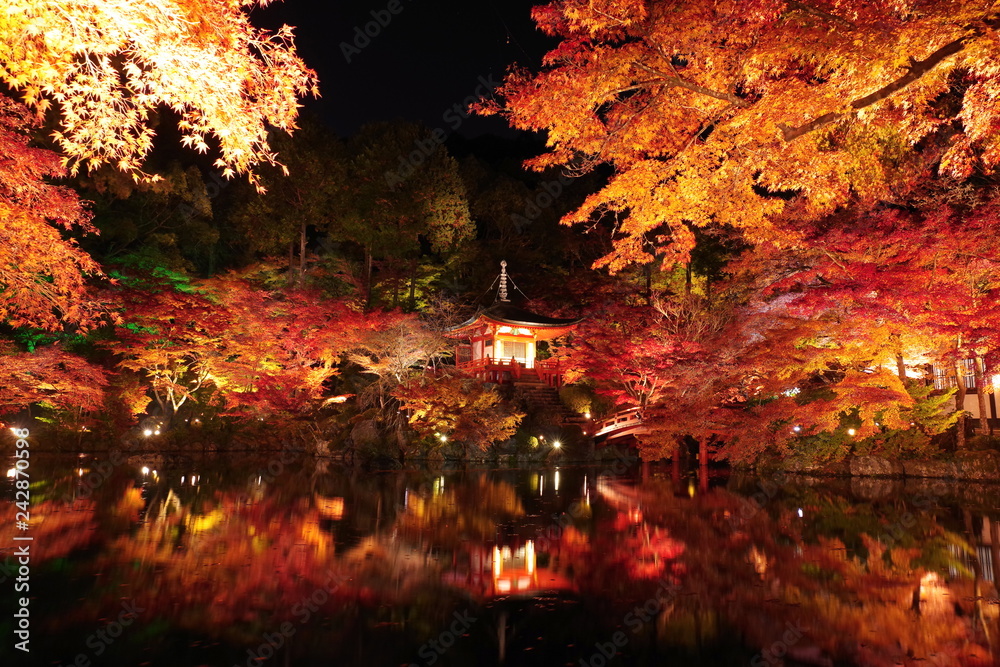
Nijo Castle (二条城)
Nijo Castle, designated as a UNESCO World Heritage Site, is located in Kyoto, Japan, and stands as a magnificent symbol of the city’s rich cultural heritage and historical significance. Built in the early 17th century by the Tokugawa shogunate, Nijo Castle served as the residence and administrative center for the Tokugawa shoguns during their visits to Kyoto.
The castle complex is surrounded by towering stone walls and fortified gates, creating a formidable defensive structure. However, what sets Nijo Castle apart is its exquisite architecture and stunning gardens, which blend traditional Japanese design with elements of Chinese and European influences.
One of the most famous features of Nijo Castle is its “Ninomaru Palace,” renowned for its ornate interiors and “nightingale floors,” which squeak when walked upon to alert against intruders. The palace’s sliding doors are adorned with intricate paintings by renowned artists of the Kano school, depicting scenes from nature, mythology, and historical events.
In addition to the Ninomaru Palace, Nijo Castle boasts expansive gardens, including the Ninomaru Garden and the Seiryu-en Garden, which offer visitors a tranquil retreat amidst lush greenery, ponds, and seasonal flowers.
Nijo Castle is not only a testament to Japan’s architectural prowess but also a reflection of its complex political history. It serves as a reminder of the power and influence of the Tokugawa shogunate during the Edo period and continues to attract visitors from around the world who come to admire its beauty and historical significance.
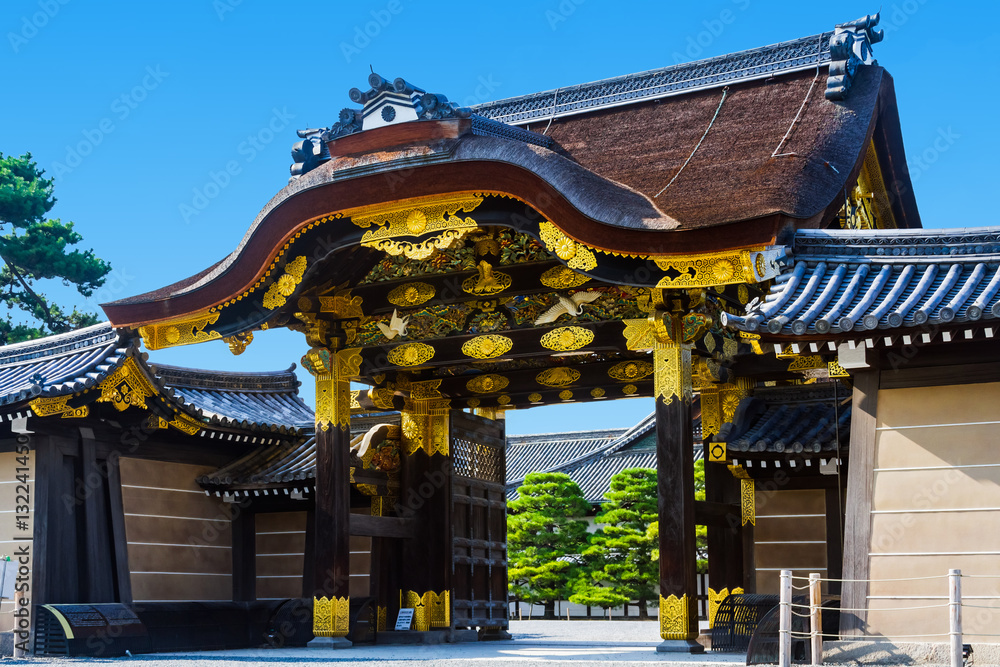
Byodo-in Temple (平等院)
located in Uji
Byodoin Temple, a UNESCO World Heritage Site situated in Uji, Kyoto Prefecture, Japan, is a magnificent representation of Pure Land Buddhism architecture and art. Originally built in 998 AD as a private villa for Fujiwara no Michinaga, a powerful politician of the Heian period, Byodoin was later converted into a temple by his son, Fujiwara no Yorimichi, in 1052.
The temple’s most iconic structure is the Phoenix Hall (Hoo-do), a national treasure and one of Japan’s most celebrated architectural gems. The Phoenix Hall’s graceful design, featuring a central hall flanked by two wings resembling outstretched wings of a phoenix, symbolizes rebirth and renewal.
Inside the Phoenix Hall, visitors can admire a magnificent 11-faced statue of Amida Buddha, surrounded by exquisite carvings, paintings, and lacquerwork. The hall overlooks a serene pond, creating a reflection that enhances its beauty and spiritual ambiance.
Byodoin Temple’s serene gardens, adorned with cherry trees, azaleas, and other seasonal flowers, offer visitors a tranquil escape from the hustle and bustle of urban life. The temple’s picturesque surroundings and cultural significance make it a popular destination for tourists and pilgrims alike.
Byodoin Temple’s Phoenix Hall is depicted on the reverse side of the 10 yen coin, further emphasizing its importance as a symbol of Japanese culture and heritage. Whether admired from afar or explored up close, Byodoin Temple stands as a testament to Japan’s rich artistic and religious traditions.
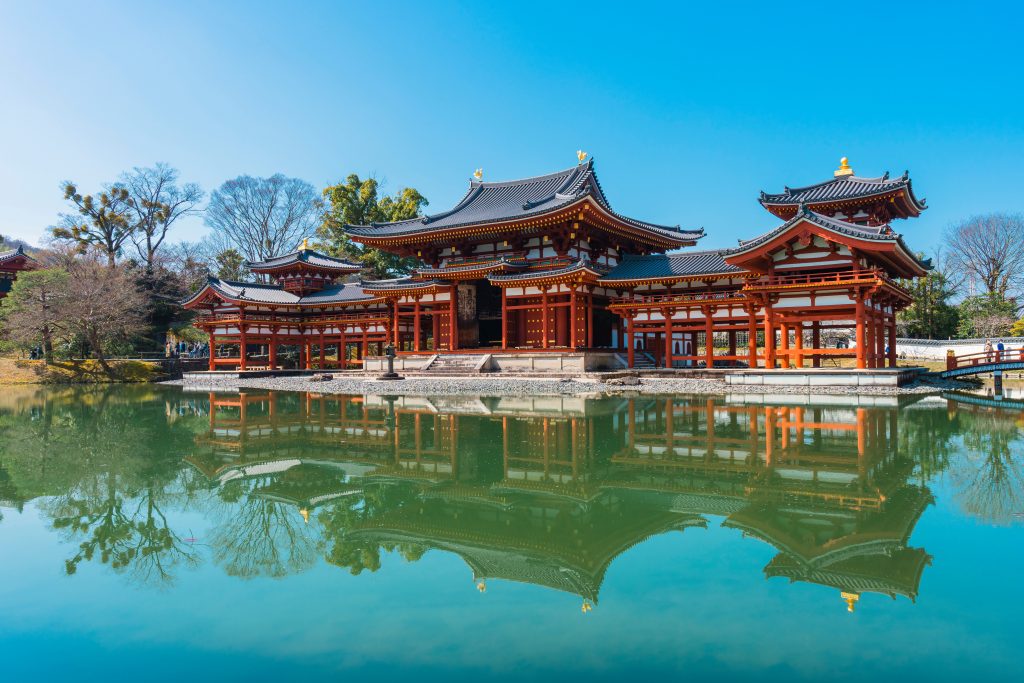
Ujigami Shrine (宇治上神社)
located in Uji
Ujigami Shrine, located in Uji, Kyoto Prefecture, Japan, is a UNESCO World Heritage Site recognized for its historical significance and architectural beauty. Believed to have been established in the 11th century, Ujigami Shrine is one of the oldest Shinto shrines in Japan and is dedicated to Ujigami-no-Kami, the guardian deity of Uji.
The shrine’s main hall, known as the Honden, features a simple yet elegant design, typical of early Shinto architecture. Constructed using cypress wood and thatched roofs, the Honden exudes a sense of tranquility and reverence, inviting visitors to pay their respects to the deity enshrined within.
Ujigami Shrine is also renowned for its beautiful natural surroundings, nestled amidst lush greenery and towering trees. The serene atmosphere of the shrine’s grounds provides a peaceful retreat for worshippers and visitors alike, offering a moment of respite from the bustling city.
One of the unique features of Ujigami Shrine is its close association with nearby Byodoin Temple, another UNESCO World Heritage Site. Together with Byodoin Temple and several other historic sites in the vicinity, Ujigami Shrine forms part of the Cultural Heritage of Ancient Kyoto, reflecting the region’s rich cultural and religious heritage.
Visitors to Ujigami Shrine can experience the tranquility of ancient Shinto rituals, explore the shrine’s picturesque surroundings, and immerse themselves in the history and spirituality of Japan’s cultural treasures.
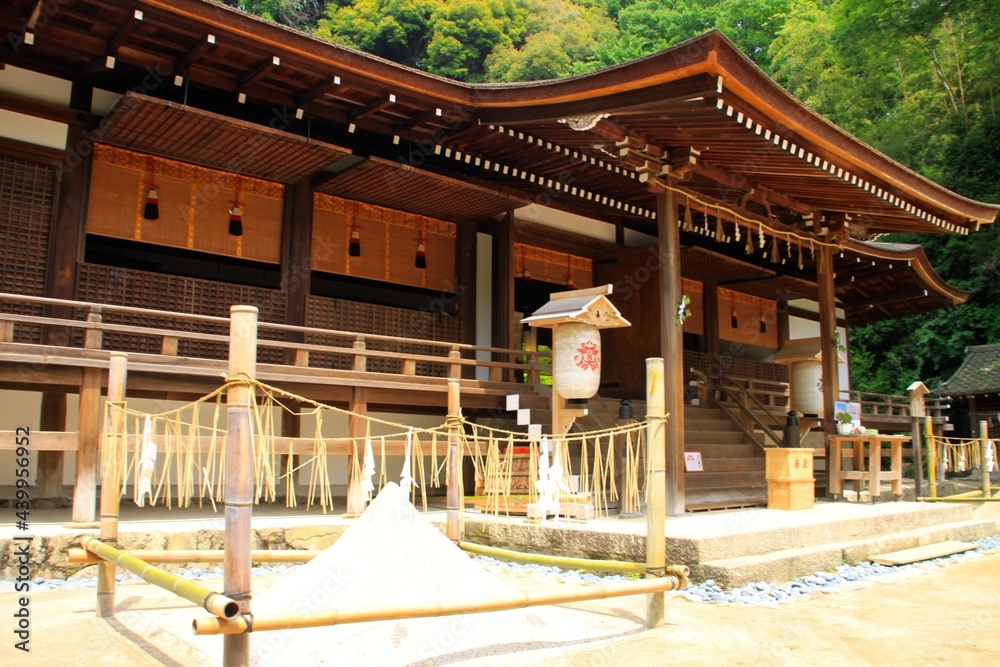
Enryaku-ji Temple (延暦寺)
located on Mount Hiei, straddling Kyoto and Otsu
Enryaku-ji Temple is a UNESCO World Heritage Site located on Mount Hiei, spanning Kyoto Prefecture and Shiga Prefecture, known as one of Japan’s centers of Buddhism. Founded in the early Nara period in 788 by Saicho, the temple flourished under the guidance of revered monks such as Kukai, becoming a central institution of Japanese Buddhism in the 9th century.
Enryaku-ji is renowned not only for its majestic mountain scenery but also for its beautiful gardens and impressive architecture. Among its notable structures are the main hall (Kondo) and the pagoda (Shariden), both of which boast historical significance and architectural beauty, attracting numerous tourists and worshippers.
Enryaku-ji is also recognized as a place for ascetic practices and meditation. Many ascetic monks have undergone rigorous training in the harsh natural environment of Mount Hiei. The temple has deep roots in Buddhist sects such as the Soto and Tendai, playing a significant role in Japanese Buddhist culture.
Enryaku-ji Temple on Mount Hiei continues to be cherished for its historical significance and stunning natural environment, offering visitors spiritual insight and physical rejuvenation.
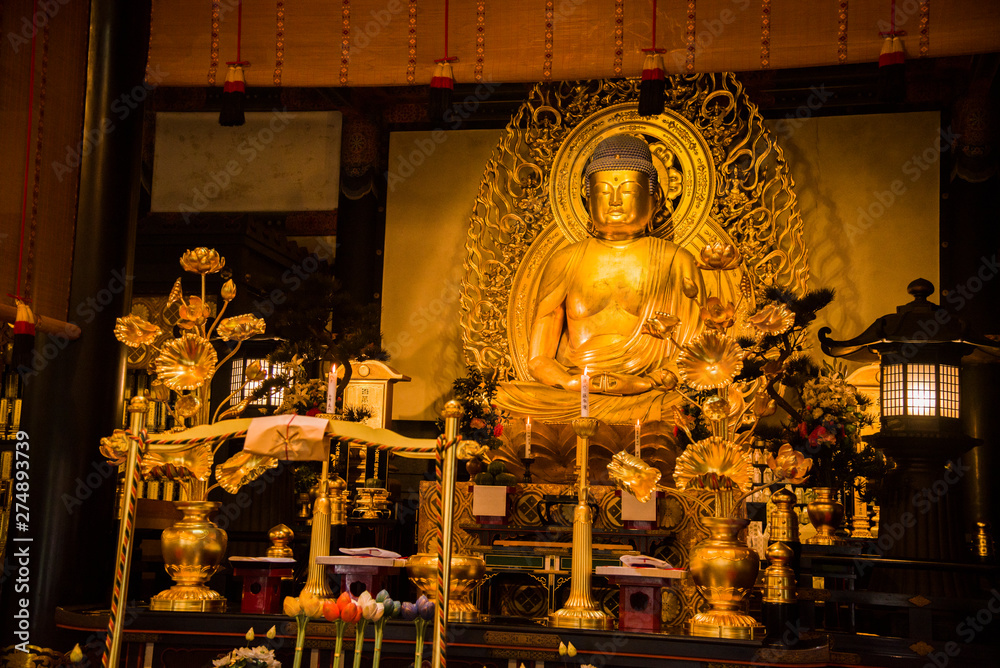
These sites represent the rich cultural and historical heritage of Kyoto and are recognized for their architectural beauty and historical significance.